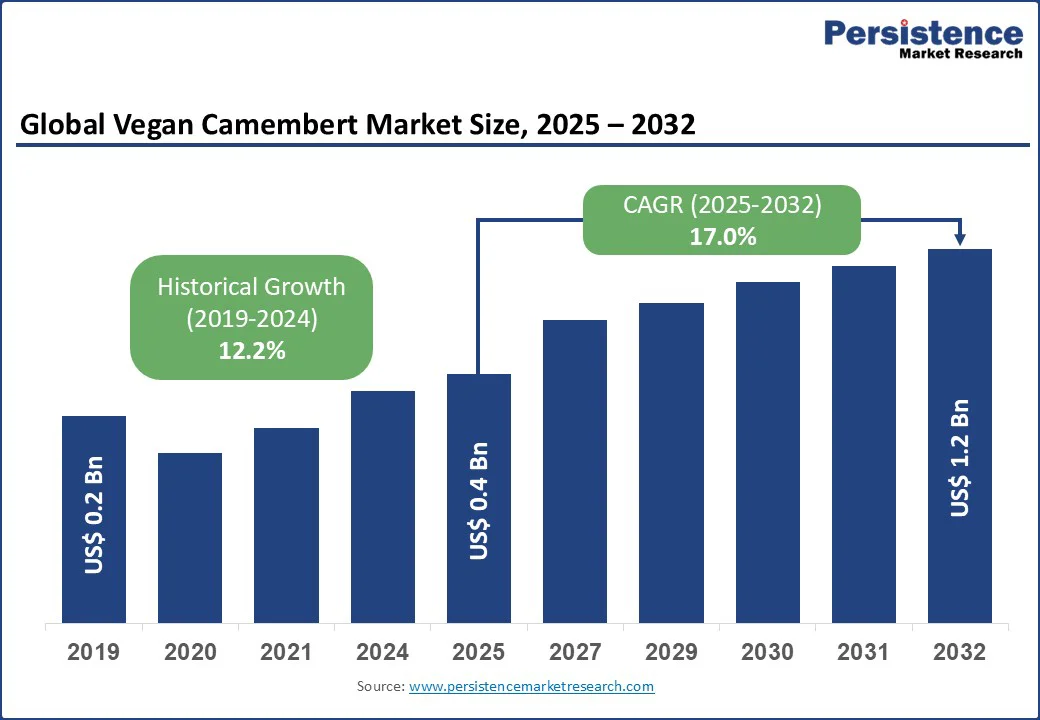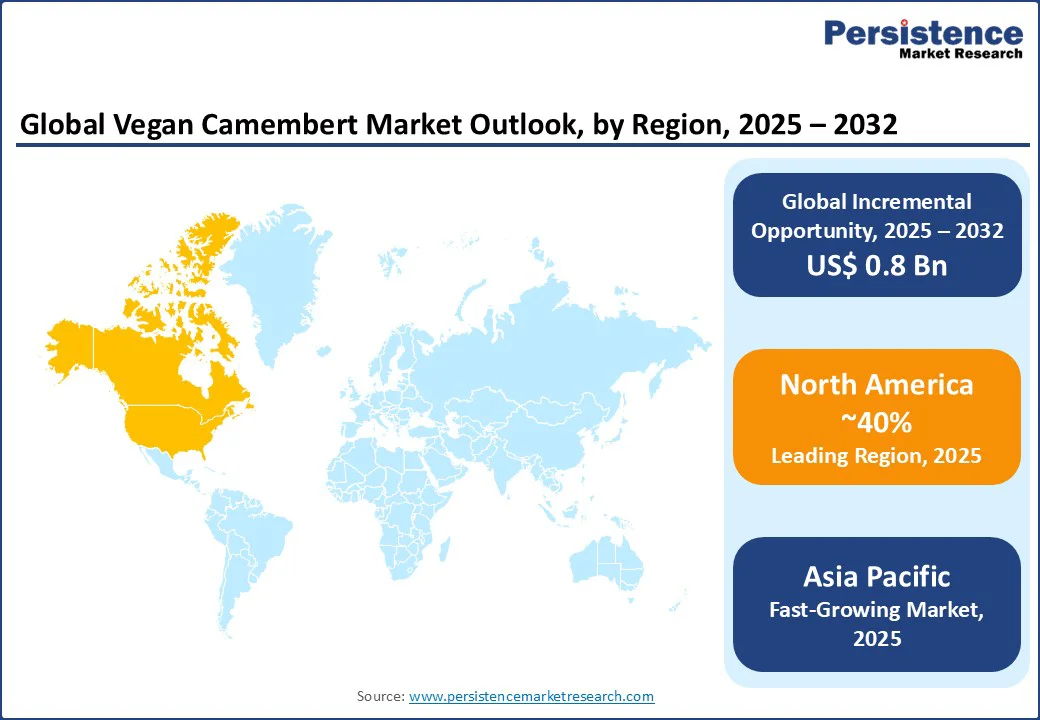ID: PMRREP32649| 183 Pages | 25 Sep 2025 | Format: PDF, Excel, PPT* | Food and Beverages

The global vegan Camembert market size is likely to be valued at US$ 0.4 Bn in 2025 and is expected to reach US$ 1.2 Bn by 2032, growing at a CAGR of 17.0% during the forecast period from 2025 to 2032.
The vegan Camembert market is driven by increasing consumer demand for plant-based dairy alternatives, growing awareness of environmental and ethical concerns surrounding traditional dairy, and advancements in food technology enabling high-quality vegan cheese production.

| Key Insights | Details |
|---|---|
| Vegan Camembert Market Size (2025E) | US$ 0.4 Bn |
| Market Value Forecast (2032F) | US$ 1.2 Bn |
| Projected Growth (CAGR 2025 to 2032) | 17.0% |
| Historical Market Growth (CAGR 2019 to 2024) | 12.2% |
The rising adoption of vegan and plant-based diets is one of the key drivers fueling the growth of the vegan Camembert market. Growing health consciousness, environmental concerns, and ethical considerations around animal welfare are pushing more consumers toward dairy-free alternatives.
Vegan Camembert, made from ingredients such as cashews, almonds, and coconuts, is gaining traction as it closely replicates the creamy texture and rich flavor of traditional cheese while aligning with plant-based lifestyles.
In regions such as North America and Europe, the growing number of flexitarian consumers who reduce but do not eliminate animal products has expanded the consumer base for vegan cheeses.
For instance, major retail chains such as Whole Foods Market and Tesco are increasing shelf space for artisanal and premium vegan cheese, including Camembert-style options. Social media and food influencers are also playing a significant role in boosting consumer awareness, making vegan cheese a trendy and accessible choice.
The vegan Camembert market faces the high production cost associated with premium plant-based cheese. Unlike traditional dairy cheese, vegan Camembert relies on high-quality raw materials such as cashews, almonds, and coconuts, which are often more expensive than milk.
The cost further escalates due to the need for advanced fermentation techniques and specialized cultures to replicate the creamy texture and rich flavor of traditional Camembert. These processes are time-intensive and require precision, adding to overall manufacturing expenses.
Packaging and distribution also contribute to elevated costs, as vegan Camembert is typically positioned as a premium artisanal product and often requires refrigeration during storage and transport. Smaller batch production, common among craft vegan cheese makers, prevents economies of scale and keeps prices higher compared to mass-produced dairy cheese.
For instance, Miyoko’s Creamery and Vromage focus on artisanal nut-based Camembert alternatives that often retail at significantly higher prices than conventional cheese. This makes premium vegan Camembert less accessible to price-sensitive consumers, particularly in emerging markets. Unless advancements in production technology and supply chain efficiency reduce costs, the high price point will remain a barrier, limiting widespread adoption despite rising demand.
The growing adoption of e-commerce and subscription-based models presents a significant opportunity for the vegan Camembert market. Online retail platforms enable manufacturers to reach a broader and more diverse consumer base beyond traditional grocery and specialty stores.
Consumers increasingly prefer the convenience of purchasing artisanal and premium vegan cheeses from the comfort of their homes, with home delivery options enhancing accessibility. Subscription models allow companies to offer curated selections of vegan Camembert and other plant-based cheeses repeatedly, fostering customer loyalty and predictable revenue streams.
For instance, Wellna Organix has introduced subscription services in the Asia Pacific, allowing customers to receive monthly deliveries of vegan cheeses, including Camembert-style options, directly to their doorstep. Similarly, The Vreamery and Miyoko’s Creamery leverage digital platforms and subscription programs to engage with health-conscious, tech-savvy consumers in North America and Europe.
Nut-based vegan camembert holds the largest share, approximately 36% share in 2025, due to its rich, creamy texture and ability to mimic the sensory profile of traditional Camembert. Cashew-based formulations, in particular, are favored for their versatility and compatibility with fermentation processes, making them a staple in products by Miyoko’s Creamery and Kite Hill.
The high nutritional value of nuts, including healthy fats and proteins, aligns with consumer demand for health-conscious plant-based alternatives. Nut-based Camembert is widely used in North America and Europe, where consumer preference for premium, artisanal vegan cheese drives demand.
Coconut-based vegan camembert is the fastest-growing segment, driven by its cost-effectiveness and scalability compared to nut-based alternatives. Coconut oil’s neutral flavor and smooth texture make it ideal for producing soft, spreadable Camembert varieties.
Companies such as Wellna Organix and Vromage are expanding coconut-based offerings, particularly in the Asia Pacific, where coconut is a locally abundant resource. The segment’s growth is further supported by increasing consumer awareness of sustainable ingredients, with coconut-based products gaining traction in eco-conscious markets.
Soft wheels and wedges dominate the vegan camembert market, accounting for a 38% share in 2025, due to their close resemblance to traditional camembert in texture and presentation. These formats are popular in grocery stores and foodservice settings, where they are used in charcuterie boards and gourmet dishes.
Companies such as Miyoko’s Creamery and Bute Island/Violife offer soft wheel Camembert that caters to premium markets in North America and Europe, where consumers value authenticity and versatility.
Spreadable chèvre-style vegan camembert is the fastest-growing product type, driven by its convenience and appeal to casual consumers. This format is ideal for snacking, dipping, and spreading, aligning with modern food trends favoring quick, versatile products.
Companies such as The Vreamery and Parmela Creamery are innovating with spreadable options, particularly in e-commerce and foodservice channels, where demand is rising in urban markets of the Asia Pacific and North America.
Grocery and supermarket channels account for over 33% of market revenue in 2025, driven by their widespread accessibility and ability to cater to mainstream consumers.
Major retailers such as Whole Foods and Tesco stock vegan Camembert from brands such as Kite Hill and Violife, making it readily available to a broad audience. The segment’s dominance is particularly strong in North America and Europe, where established retail infrastructure supports high-volume sales.
E-commerce and subscription-based channels are the fastest-growing distribution segment, fueled by the rise of online shopping and direct-to-consumer models. Platforms such as Amazon and specialty vegan retailers offer a wide range of vegan Camembert products, with subscription services providing recurring delivery options.
Companies such as Nafsika’s Garden and Wellna Organix are leveraging e-commerce to reach global consumers, particularly in the Asia Pacific, where online retail is expanding rapidly.

North America represents a leading region, holding a 40% share, for the global vegan Camembert market, with the U.S. at the forefront due to its advanced food processing infrastructure and high consumer acceptance of plant-based diets.
The sector is primarily driven by increasing health consciousness, environmental awareness, and dietary preferences that favor dairy alternatives. Consumers are actively seeking products that align with ethical considerations and support sustainability, making vegan Camembert a preferred choice for both vegans and flexitarians.
Premium nut-based Camembert offerings from companies such as Miyoko’s Creamery and Kite Hill have gained significant traction, valued for their creamy texture and authentic flavor that closely mimics traditional cheese.
Urban centers, particularly areas with high population density and health-focused lifestyles, are key markets where grocery chains, specialty stores, and artisanal outlets facilitate easy access and widespread adoption. Investments in food technology, including innovative fermentation and aging techniques, are enhancing product quality and taste, further attracting consumers.
Europe represents a significant market for vegan Camembert, driven by strong vegan and sustainability movements in countries such as the UK, Germany, and France. Consumer awareness around ethical eating, environmental impact, and health benefits of plant-based diets has led to increasing acceptance of dairy-free alternatives, including artisanal and premium vegan cheeses.
In the UK, rising interest in vegan lifestyles has expanded for brands such as Bute Island/Violife, which offer innovative Camembert-style products catering to both vegans and flexitarians.
Germany’s emphasis on organic and plant-based diets supports the growth of coconut- and nut-based Camembert, while in France, a country with a rich cheese tradition, consumers are gradually embracing plant-based alternatives. Companies such as Nafsika’s Garden are innovating with authentic flavor profiles to meet local taste preferences and maintain quality standards expected from traditional cheese products.
Asia Pacific is the fastest-growing region in the vegan camembert market is driven by rising disposable incomes, increasing health consciousness, and growing awareness of plant-based diets in countries such as China and India. Consumers are showing greater interest in sustainable and ethical food choices, which has fueled demand for dairy-free alternatives, including premium vegan cheeses.
In China, the plant-based cheese market is expanding rapidly, with coconut- and nut-based Camembert gaining popularity due to local ingredient availability and increasing consumer acceptance of international plant-based products. In India, the urban population is gradually adopting vegan diets, and companies such as Wellna Organix are leveraging e-commerce channels to reach tech-savvy, health-conscious consumers efficiently.

The global vegan camembert market is highly competitive, with a mix of established plant-based dairy leaders and specialized artisanal producers. In North America and Europe, companies such as Miyoko’s Creamery, Kite Hill, and Violife dominate through advanced R&D in fermentation techniques, premium nut-based formulations, and strong product portfolios.
In the Asia Pacific, rapid growth in e-commerce and rising vegan consumer bases are attracting investments from regional players such as Wellna Organix and Nafsika’s Garden, who focus on cost-effective and innovative plant-based alternatives.
The global vegan Camembert market is projected to reach US$ 0.4 billion in 2025.
The rising adoption of vegan and plant-based diets, coupled with advancements in food technology, is the key market driver.
The vegan Camembert market is poised to witness a CAGR of 17.0% from 2025 to 2032.
The growing adoption of e-commerce and subscription-based models in decentralized retail settings is a key market opportunity.
Miyoko’s Creamery, Vromage, Bute Island/Violife, Kite Hill, The Vreamery, Parmela Creamery, Nafsika’s Garden, and Wellna Organix are key market players.
| Report Attribute | Details |
|---|---|
| Historical Data/Actuals | 2019 - 2024 |
| Forecast Period | 2025 - 2032 |
| Market Analysis | Value: US$ Bn, Volume: As Applicable |
| Geographical Coverage |
|
| Segmental Coverage |
|
| Competitive Analysis |
|
| Report Highlights |
|
By Ingredient
By Product Type
By Distribution Channel
By Region
Delivery Timelines
For more information on this report and its delivery timelines please get in touch with our sales team.
About Author